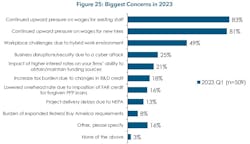ACEC Study: Engineering Sentiment Still Strong
PRESS RELEASE
Washington, DC, March 2023 -- The ACEC Research Institute has released the results of its Q1 2023 Engineering Business Sentiment Study. The report showed that optimism within the industry remains extremely high across the board, among all market sectors and within all geographic regions.
The results were unveiled in a webinar hosted by Institute Executive Director Daphne Bryant and Senior Research Consultant Joe Bates, who led the study. Bates pointed to the overall robust health of the industry, which has roared back from a COVID-driven 6.6% dip in output in 2020. “We rebounded very nicely in 2021,” said Bates. “And we surpassed the 2019 numbers, so we hit a new record.”
The industry further built on those record-setting gains in 2022.
Those gains have fed the deep optimism within the industry, with sentiment improving in two-thirds of sectors over last quarter. Future sentiment also rose slightly and remains firmly in the positive column.
- Based on 583 responses to an ACEC members survey conducted January 12 to 25, 2023.
One metric of particular note: Survey respondents also are feeling much more bullish about the U.S. economy than in previous quarters, with sentiment jumping back into positive territory from its low in the third quarter of 2022. Overall, 41% of respondents feel positively about the condition of the U.S. economy, while 29% feel negatively. Some 30% were neutral. Still, the 41% positive equals a Net Rating of +12, up 12 points from last quarter, and a 27-point leap from its Q3 2022 low.
Not surprisingly, ongoing inflation (86%) and a potential recession (87%) are recurring areas of concern among respondents, but inflation concerns are falling.
Labor shortages also remain a key concern, with nearly half of firms reporting turning down work due to insufficient workforce. Discussing these labor shortages, Bates pointed to an important distinction between not enough people "in" the labor market, versus not enough people "participating" in the labor market. He noted that participation dropped precipitously in 2020 as a result of COVID layoffs, shutdowns and stoppages. The labor market has largely returned to work but remains a full percentage point lower than it was pre-COVID.
“That 1% translates into one and a half or two million people that are still sitting on the sidelines for one reason or another,” Bates said. One possible reason is that nearly four million people are still dealing with long COVID and are unable to work.
“That would more than make up for that 1% that we are seeing and would take us above where we were before the pandemic,” he concluded.
The study finds that 88% of firms have at least one job opening, down slightly from 91% last quarter. The largest firms (more than 500 employees) have a median of 80 open positions, down 20 from last quarter. Still, the numbers are significant in terms of percentage of firms’ workforces. “The data that we are collecting suggests about 10% of their total firm staff size is in an open position,” Bates calculated.
##########

